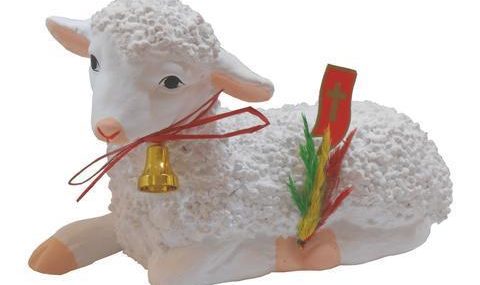“Christ is risen”
Resurrection Sunday is the most crucial event in the calendar of the Catholic Church because it constitutes the essence of Christianity. Today, as in the past, the celebration of Easter begins with a resurrection, i.e., a solemn Holy Mass preceded by a procession. The name “resurrection” comes from Latin and means rising from the dead. This dawn mass begins with a three-fold procession around the church. At the head of the procession is a cross decorated with a red stole, followed by a figure of the Risen Christ and a monstrance with the Host. While the bells are ringing, the Blessed Sacrament is carried around the temple three times in procession. The celebration of the resurrection liturgy gathers large crowds of believers who express the joy of resurrection by singing the songs “Wesoły nam dzień dziś nastał” and many others. We often hear the word “hallelujah” in Easter songs. It comes from the Hebrew hallelujah and means “glorify Yahweh.”
Easter celebrations have changed over the centuries. Jerzy Kitowicz, in his Description of customs during the reign of Augustus III, mentioned that the resurrection procession took place at different times: in large cities – at midnight, in cathedrals – on Saturday at 9 p.m., and in small towns and villages – on Sunday at sunrise. Currently, in some cities, the Resurrection of Christ is celebrated during the Holy Saturday service, but most often, Sunday, the first holiday in Christianity, is the celebration of the Resurrection.
Bells and gunshots announce the joy of Christ’s resurrection. During the Resurrection, shooting from cannons, mortars, and firecrackers was common. This bang may result from Easter joy and the desire to awaken the world to live in spring. This custom has survived to modern times and is practiced primarily by young people.
After the Resurrection, the farmers who came to mass in horse-drawn carriages organized a horse race. The idea was to get to the cottage as quickly as possible. It was believed that it brought a successful harvest, ensured abundant harvests, happiness, health, and success, and announced leadership in all fieldwork. When everyone managed to return from church, the home celebration began.

Easter breakfast – Święconka
Home celebrations in the past and today start with breakfast with the closest family. It is an expression of joy over the empty tomb and the Resurrection. This ritual feast unites the living and the dead and has a ceremonial dimension.
Easter breakfast is preceded by prayer and sharing a blessed egg – a symbol of life, fertility, love, vitality, and making wishes. Sharing an egg is a custom from Roman culture, in which feasts began with eating eggs. Piotr Kowalski emphasizes that there is also a mythical justification for sharing an Easter egg, just like sharing a wafer during Christmas, because it is not only about the bond created by the food eaten together but also about the fact that it becomes one of the gifts exchanged by the revelers. The wishes made then are another gift – words that have the magical power to create (renew) the world (Magical culture. Omen, superstition meaning). In Polish tradition, the man who was the head of the family distributed pieces of eggs to those gathered, expressing wishes. All household members exchanged wishes and shared eggs. This tradition is still alive and cultivated.
In the old days, after sharing an egg, each household member, without exception, had to eat a grated horseradish stick. It was a form of mortification and a “medical” procedure that had to be undergone before a sumptuous and tasty feast. Horseradish consumption was a small part of bitterness that had to be shared with Christ, who was watered with vinegar on the cross. This natural bactericide and fungicide protect against various ailments. Eating horseradish can also be considered a magical apotropaic agent that protects against evil forces traditionally afraid of spicy spices such as garlic or horseradish. After the ceremonial opening of the Easter breakfast, you could enjoy the festive delicacies. For some former village inhabitants, it was the only opportunity a year to eat their fill and taste meat or sausages. Many years ago, Łukasz Gołębiowski noted the abundance of Easter tables: Holy. This is the custom of our country. On this day, the peasant and the poorest person can buy at least a piece of pork, a sausage, a cake, and eggs, while the wealthier will buy more magnificently blessed ones (The Polish People and Their Customs).
The Easter table was decorated with colorful Easter eggs, green boxwood branches, catkins, and the first flowers. The table had to include a lamb, often placed on a cress or young oats meadow. The lamb, once called an Angus lamb, was made of dough, wax, butter, and nowadays also of sugar paste and chocolate. The Easter lamb with a red banner is a symbol of the Risen Jesus but also of humility and innocence. Once upon a time, almost every household had a baking tin for baking lambs.
According to tradition, no hot dishes were served on Holy Sunday because no hard work should be done on major holidays, which included lighting a fire, working in the kitchen, and cooking. All dishes were cooked in advance and were only reheated or eaten cold on Easter Sunday. In the villages, the rule was followed that Easter food should be prepared “without smoke” or with “one smoke,” which meant only warmed up. The only warm dish was Easter żurek or borscht. Ethnographers are happy to answer the question of which soup should be eaten for Easter breakfast: borscht or żurek, but there is no agreement among them because the type of soup depends on the region. What is the difference between żurek and white borscht (barszcz)? It is often assumed that żurek is made with sourdough from wholemeal rye flour, and white borscht is made with wheat flour. Both soups are served with eggs and cold meat, usually white sausage.
The Easter table had to include blessed foods. It was believed that holy water and prayer over food made it sacred and protected against the effects of excessive gluttony. According to tradition, you had to taste every dish. A piece of blessed bacon was left for the whole year. According to folk beliefs, it had properties that accelerated the healing of wounds.
Game, beef, veal, pork, poultry, and rabbit dishes dominated the tables of magnates and nobility. The most critical Easter meat was smoked and steamed ham. Sausages and pâtés were also served. The delicacy was white sausage and głowizna (pig’s head). The meat dishes were accompanied by horseradish, beetroot, and other sauces. The peasant table was more modest. Eggs in various forms and cold meats were a must. In impoverished peasant families, cold meats were replaced with scrambled or hard-boiled eggs and a piece of bacon. If there was sausage, there was very little of it. However, there was no shortage of bread. It should also be added that nothing from the feast could be wasted. Egg shells were taken to the flower beds for vegetables, the orchard for trees to bear fruit, and mixed with poultry feed for good breeding. Easter egg shells placed under fruit trees were supposed to ensure fruit harvest because the egg then gave its fertility powers. In the Przemyśl region, it was believed that the remains of Święconka buried in the garden would grow maruna – a herb with white and yellow flowers that was a cure for stomach pain (Małgorzata Dziura, Four Seasons. About work and celebration in the Przemyśl region).

Easter breakfast was always sumptuous and plentiful. Every region in Poland can boast a culinary Easter tradition. Despite changing culinary fashions, the Easter table is still dominated by dishes prepared by our great-grandmothers, grandmothers, and mothers. There are egg dishes, cold cuts, baked meats, sour rye soup, and sweets, especially Easter cake. In the past, Easter breakfast, the central feast of the spring holidays, was a return to the table of dishes forbidden during Lent. Today, the Lenten menu is not so restrictive.
Celebration of the first day of Easter
Easter feasting lasted all Sunday. At that time, the villagers did not receive guests or visit each other. This was related to the folk belief that on great holidays, the souls of the dead return to meet their loved ones, so it was necessary to be home. The farmers only went into the fields and watched the winter crops grow. On the first day of Easter, the village population also visited cemeteries, turned on the lights, and left some food for their dead. The visit to the cemetery was a symbolic conveyance of the news that Christ had risen and they too would rise from the dead.
After eating the ceremonial breakfast, it was tradition to rest. However, it was impossible to sleep because it could fail the wheat harvest, the overgrowth of potatoes with weeds, and the failure of mushroom picking. The festive character of Easter Sunday was emphasized by doing nothing. There was no cleaning or cooking in rural houses; people only talked, played, and sang. Young people especially organized various games; for example, “walk,” also called “kibitka,” was popular. This game comes from the old All Souls’ Day customs, when eggs were rolled on graves and later given to people experiencing poverty. This Easter game involves tapping Easter eggs or moving them on the table. The winner was the one whose egg broke the latest. The winner took the broken egg. Sometimes, the boys would play a game of throwing Easter eggs over the roof of a church or a cottage. Today, these practices have entirely disappeared. From the resurrection on Holy Sunday, throughout Easter, people greeted each other with the words: “Christ is risen.” The answer was: “He is truly risen!” Today, this Easter “good morning” is still used in many towns in Poland.
Easter Sunday is associated with many religious experiences, folk beliefs, customs, and superstitions. It commemorates the truth about the resurrection of Christ and is the holiday that stands out most from everyday life. The different behaviors, beliefs, and rituals make Easter Sunday an extraordinary time.
The article was based on material Dr. Małgorzata Dziura prepared from the National Museum of the Przemyśl.









